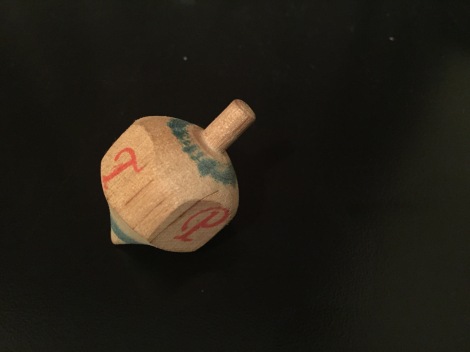Whilst visiting Portugal this past summer, I was given a gift. It appeared to be a dreidel, though I was told that it was actually a Rapa, a Portuguese top used by children during Christmas. The store’s website though, claims that it is based upon the dreidel, a traditional Jewish game. The Sephardic origins of the dreidel have also been asserted by some in the American Southwest. There are Spanish individuals in that region who posit Jewish Sephardic ancestry. They claim that hundreds of years ago they arrived in the farthest northern reaches of what was then Spanish Mexico to escape the Inquisition. Some researchers have attempted to prove this Jewish ancestry based upon dreidels that have been found in some of their homes.
The word dreidel is of course yiddish (a Judeo-German language spoken by Ashkenazim). The word is likely from the Yiddish word drei, to spin, as in ‘to drei a kup’ which basically means to drive someone crazy. The letters on the sides are nun, gimmel, hey, and shin – which may stand for nes gadol hayah sham (a great miracle happened there). It was in 1887 that the Hebrew word sevivon was first created by Itamar Ben-Avi, the son of the great Hebrew revivalist Eliezer ben Yehuda. The story goes that he was five at the time, playing with the dreidel. He took the Hebrew word for turning, saviv, and created the word sevivon, for a spinning top. Later in Israel the shin (for sham – there) was changed to a peh (for po – here).
The game of dreidel is today widespread throughout the Jewish world. A player spins the top, and depending on how it lands, they win or lose part or all of the pot of coins (or gelt in Yiddish), in the middle. The origins of this game are said to date back to Hanukkah times (165 BCE), when Jews would play dreidel as Greek soldiers entered their homes,. They did this to hide the fact that they had actually gathered to study Torah, an act prohibited by the Syrian-Greek king, Antiochus. Significantly though, according to the Seforim Blog, this dreidel origin story only first appeared in print in a book published in Pittsburgh, PA, in 1890! The author, Rabbi Eliezer Hershovitz, came from Kovno, Lithuania.
So, is it possible that the dreidel is in fact a pan Jewish custom, dating back to ancient times, and perhaps even Sephardic in origin? Probably not. Not only is dreidel a yiddish word, and not only does the origin story only appear in the late 19th century, but similar tops are found across Europe, and in some places are even traditionally played at Christmas time. In Portugal it is called a Rapa, in other European cities it was a called a teetotum. Depending on the country and language, the letters appearing on the four sides are different. In Yiddish the Hebrew nun, gimmel, hey, and shin actually stood for nisht, ganz, halb, and shtel arayn (nothing, everything, half, and give one).
The dreidel therefore is a cautionary tale, wherein we sometimes mistakenly project back in time, something which we know from the present. Because Jews today so famously play with a dreidel, some mistakenly assume that any four-sided spinning top must have come from the Jews, even the Sephardic Jews. There is, however, a lasting message and value contained within the dreidel.
Rabbi Joseph Dweck of the S&P Sephardi Community of London recently pointed out that Jews are often the repository of the world’s cultures and traditions. As we traveled through the exile we picked up various cultural items, whether food, music, intellectual pursuits, languages, or games, and we incorporated them into Judaism. Then, even when those traditions are lost in their places of origin, they remain alive through the Jewish people. That is an amazing insight about the Jewish people and can be seen in many different cultural areas. Sephardic Jews, in fact, played an incredibly important role in restoring philosophy to Christian Europe after the Dark Ages, via Muslim Spain where it had been preserved.
Hanukkah marks the fight against the Greeks and the Greek culture, called Hellenism. Many therefore hold up Hanukkah as the Jewish banner for rejecting all things deemed non-Jewish. It is therefore incredibly ironic, that one of the customs most associated with Hanukkah, is in fact gentile in origin! But that of course so acutely conveys a central lesson. Judaism does not reject Gentile culture. What we reject is totally discarding Judaism for the prevailing culture, as some did during Greek times. Rather, as Jews we are always keen to learn from the world around us. When we find elements that we value and are in consonance with Judaism, we gladly incorporate them into our tradition. We find a way to transform them and to make them fit into Judaism. In so doing, we take the best of the world and preserve it, recognizing that there is goodness all around us. Hanukkah then is not about rejecting ‘Greek culture,’ but about finding ways to incorporate positive elements of that culture into Judaism. Perhaps then, there is something particularly ‘Jewish,’ Sephardic and Ashkenazic alike, about the dreidel.

My family comes from Istambul. Turkey, and before that from Toledo,
We are as sephardic as it gets. I never saw a dreidel in my grandparents home.
I`ll ask around to the elders of our kahal and see if someone ever saw a dreidel in the old country.
In the other hand, in Brazil,were we`ve been fo the last 90 years, and is a country colonized by Portuguese, there are some toys quite similar to a dreidel.
Thanks Victor. Yes, I would highly doubt that they’d have seen one as it was a European toy/game. Definitely not a Jewish game originally.